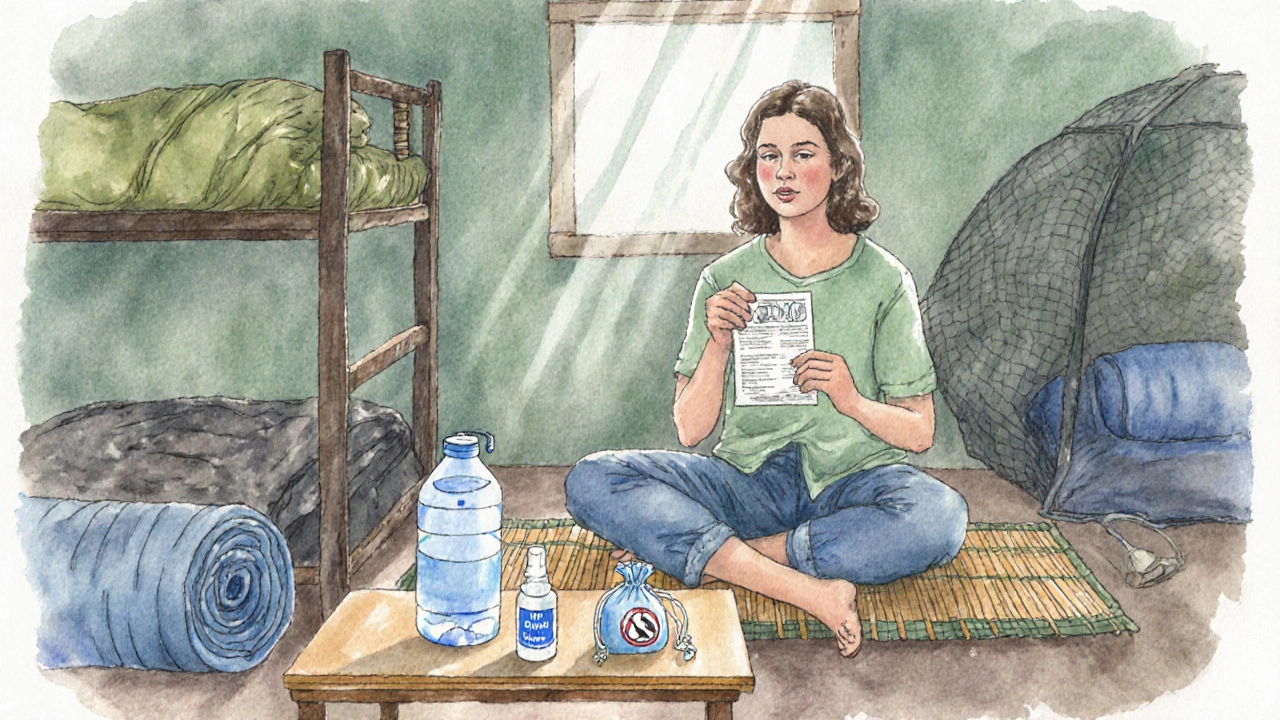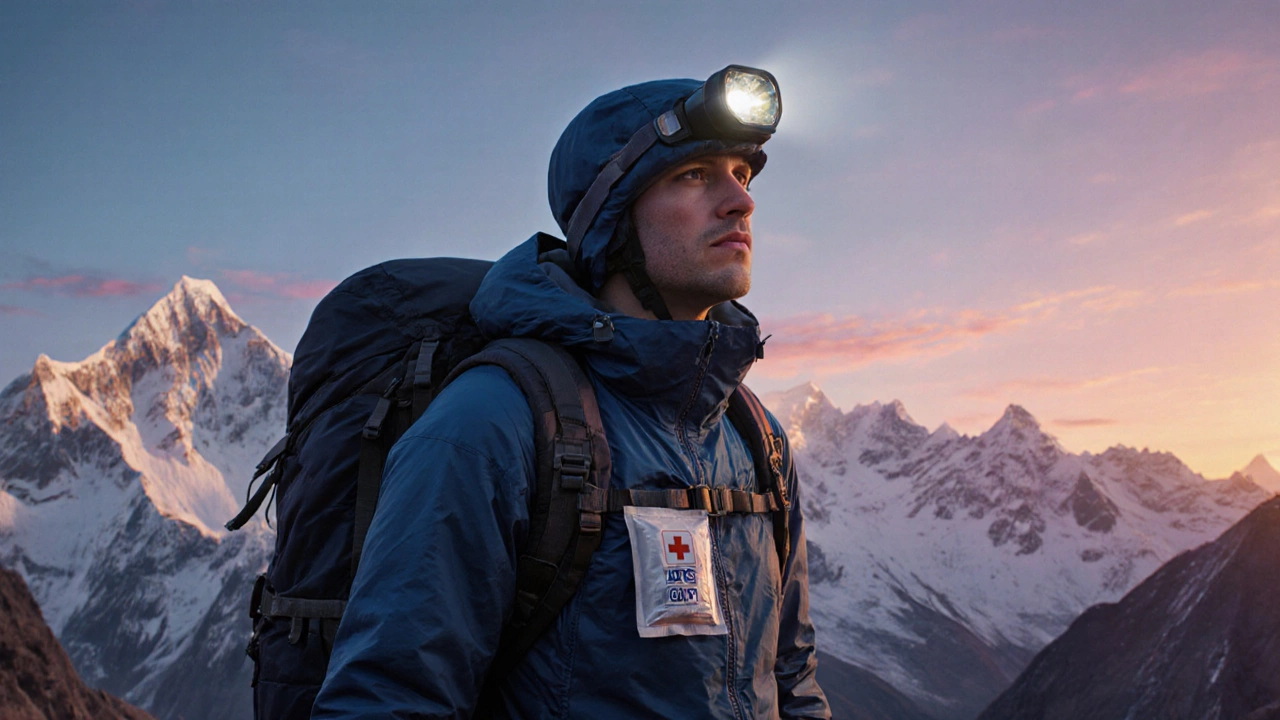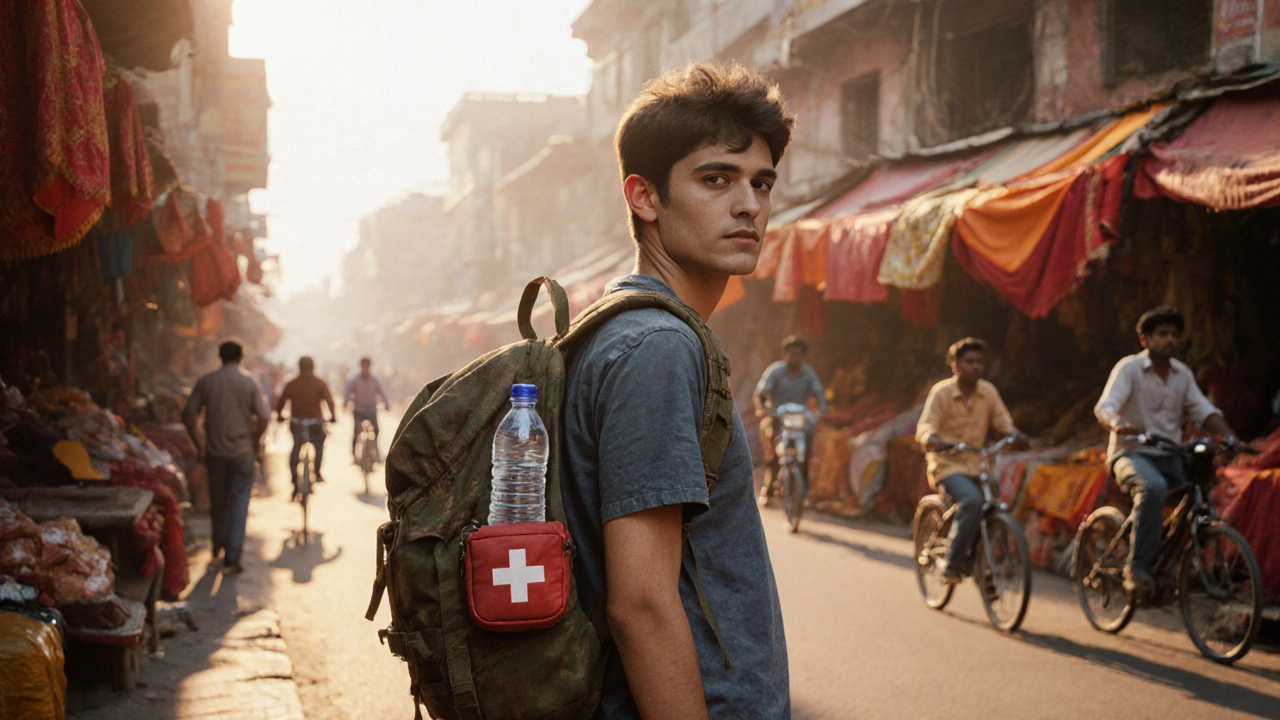Traveling through India on a shoestring budget can be an unforgettable adventure, but staying healthy is the real secret to enjoying every moment. Below you’ll find straight‑forward steps that keep you feeling good without blowing your budget.
Travel health is the practice of protecting your body from illness while on the move, especially in places where water, food, and climate differ from home. Proper planning, vaccination, hygiene, and quick response to symptoms can turn a risky trip into a smooth ride.Know the most common health risks in India
Before you book a hostel or hop on a shared rickshaw, it helps to understand what ailments travelers usually face. The table below lines up the top culprits with simple preventive actions.
| Illness | Typical Symptoms | Key Prevention |
|---|---|---|
| Traveler’s diarrhea | Loose stools, cramping, nausea | Drink bottled or filtered water; cook food thoroughly; avoid raw salads unless peeled |
| Typhoid fever | Fever, headache, abdominal pain | Get an typhoid vaccine; practice strict hand‑washing; choose hot‑cooked meals |
| Malaria | Fever, chills, sweats | Use insect repellent with DEET; sleep under mosquito nets; consider prophylactic meds in high‑risk areas |
| Dengue | High fever, joint pain, rash | Same mosquito precautions as malaria; wear long sleeves during daylight hours |
| Hepatitis A | Fatigue, jaundice, dark urine | Vaccinate before departure; avoid uncooked shellfish and street‑vendor ice |
| Altitude sickness (in Himalayan regions) | Headache, dizziness, shortness of breath | Ascend gradually; stay hydrated; consider acetazolamide if you’re prone |
Vaccinations: The first line of defence
Most travellers to India benefit from at least two shots. Vaccinations are preventive injections that stimulate your immune system to fight specific pathogens. The core set includes:
- Typhoid - especially if you’ll be eating from local stalls.
- Hepatitis A - highly recommended for all budget travellers.
- Hepatitis B - advisable if you expect medical treatment or close contact with locals.
- Routine shots (MMR, Tdap, varicella) - make sure they’re up to date.
For rural Himalayan treks, add Japanese encephalitis and a malaria prophylaxis plan. Schedule your appointments at least six weeks before you leave, so immunity has time to build.
Water and food safety without splurging
Good Food safety practices help you avoid food‑borne illnesses while keeping meals affordable is mostly about being selective, not about buying pricey bottled water every hour.
- Drink only sealed, commercially bottled water. Check that the seal isn’t broken.
- If you’re on a train or bus, bring a portable UV water purifier or a simple chlorine tablet kit. Both cost under $10 and last for months.
- Eat cooked foods that are served hot. A steaming bowl of dal or a fresh‑hot dosa is safer than a room‑temperature salad.
- Avoid raw fruits unless you can peel them yourself. Bananas, mangoes, and guavas are safe after peeling.
- Use your own cutlery when possible. Many travelers carry a lightweight bamboo fork and spoon.
Beat the bugs: Mosquito‑borne illnesses
India’s tropical climate breeds mosquitoes that carry malaria, dengue, and chikungunya. Mosquito‑borne illnesses are diseases transmitted through the bite of infected Aedes or Anopheles mosquitoes can hit hard, especially on a tight budget where medical care may be far away.
- Apply a DEET‑based repellent (30%-50%) on exposed skin every 4‑6 hours.
- Sleep under a portable mosquito net treated with permethrin. Nets are inexpensive and reusable.
- Choose accommodation with screened windows or air‑conditioning. If none, hang a net over your sleeping area.
- Dress in long sleeves and pants during dawn and dusk, when Aedes mosquitoes are most active.
For high‑risk zones (e.g., parts of Assam, West Bengal, and the Andaman islands), talk to a doctor about taking prophylactic antimalarial tablets such as doxycycline or atovaquone‑proguanil.
Travel insurance that covers health emergencies
Even if you’re trying to keep costs low, skipping insurance is a gamble you don’t want to take. Look for a policy that includes:
- Emergency hospitalisation and evacuation.
- Coverage for pre‑existing conditions (if applicable).
- 24‑hour tele‑medical assistance - many insurers have an app you can use anytime.
Budget‑friendly options from providers like World Nomads, SafetyWing, or IMG can be purchased for under $5 per week. Keep a digital copy of your policy on your phone and store the insurer’s hotline number in your contacts.

Know where to get medical help
India’s healthcare system varies widely. In big cities you’ll find world‑class private hospitals; in remote villages, a basic clinic or even a qualified pharmacist may be all you get.
- Major urban centres (Delhi, Mumbai, Bangalore, Chennai) have English‑speaking doctors and up‑to‑date facilities. Keep a list of reputable hospitals such as Apollo, Fortis, and Max.
- For rural trekking routes, identify the nearest government clinic or charitable hospital. The charity AIIMS All India Institute of Medical Sciences, a network of top‑tier public hospitals often runs outreach clinics.
- Carry a basic first‑aid kit with oral rehydration salts (ORS), antidiarrheal tablets, and a small supply of broad‑spectrum antibiotics (only if prescribed by a doctor).
Everyday hygiene habits that make a big difference
Small routines can stop big problems:
- Wash hands with soap and clean water for at least 20 seconds before meals and after using the toilet. If soap isn’t available, an alcohol‑based hand sanitizer works well.
- Keep your nails trimmed; bacteria love hidden dirt.
- Don’t share personal items like towels, razors, or water bottles.
- If you feel a fever creeping up, rest, hydrate, and seek medical attention early - early treatment prevents complications.
When you do get sick: Fast‑track your recovery
Even the best‑prepared traveler can catch something. Here’s a quick action plan:
- Identify the symptoms - use the table above as a reference.
- Hydrate with oral rehydration solution (ORS) or bottled water mixed with a pinch of salt and sugar.
- Take over‑the‑counter meds: loperamide for mild diarrhea, paracetamol for fever, and antacids for stomach upset.
- If symptoms persist beyond 48 hours or you develop severe vomiting, blood in stool, or high fever, head straight to the nearest clinic.
- Use your travel insurance’s emergency line - they can often arrange transport to a better‑equipped hospital.
Quick checklist before you depart
- Book a travel‑health consultation 6‑8 weeks before departure.
- Get typhoid, hepatitis A, and any region‑specific vaccines.
- Pack a compact water‑purification kit, mosquito repellent, and a lightweight net.
- Purchase a basic travel‑insurance policy that covers medical evacuation.
- Download offline maps and list of emergency hospitals for the states you’ll visit.

Do I need a visa to travel for health reasons in India?
Yes. India requires a visa for most foreign nationals regardless of the purpose. You can apply for an e‑tourist visa online, which is valid for up to 180 days. Medical‑tourist visas are also available if you plan to seek treatment.
Is bottled water safe everywhere in India?
Most reputable brands are safe, but always check that the seal is intact. In remote areas, stick to boiled or filtered water, or use a portable UV purifier.
How can I treat traveler’s diarrhea on a budget?
Rehydrate with oral rehydration salts, take loperamide for mild cases, and avoid solid food for a few hours. If symptoms last more than two days, see a clinic for antibiotics.
What’s the cheapest way to protect against malaria?
Use a DEET repellent and sleep under a mosquito net. In many low‑risk areas, prophylactic medication isn’t required, but always ask a local doctor if you’re unsure.
Can I rely on Indian street food if I’m careful?
Street food can be delicious and safe if it’s cooked fresh in front of you, served hot, and you see good hygiene practices. Stick to vendors with high turnover and avoid raw items.
